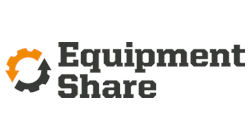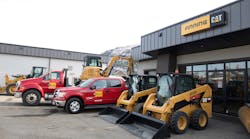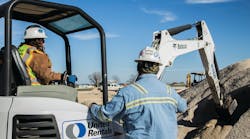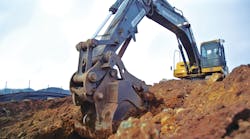1 Anticipate your exit
When pulling in for a delivery and before parking the vehicle, anticipate your options for departure. “Know your exit before you make your entrance,” says Mark Safsten, director of safety & risk, Sunstate Equipment. “If possible, when parking the vehicle, set the vehicle in the best direction or position for an easier departure.”
2 Set cones around the corners
“This not only creates greater visibility of the driver and vehicle, but it also gives the driver a chance to evaluate any new hazards around the vehicle while picking up the cones,” Safsten counsels. “This process improves the driver’s awareness of any hazards and makes for a safer departure.”
3 Plan in advance
When scheduling the delivery of pickup, try to confirm that the intended loading/unloading area is in a designated area that is adequately lit, free of people, and equipment or vehicles that are not essential to the loading or unloading process.
4 Training is essential
Training is as much a key to proper delivery as any other aspect of work at a rental center. Drivers should be trained in the general safety precautions to take when visiting sites, especially in regard to safety risks. They should have clear instructions about what to do if they are not satisfied with the arrangements for ensuring safety at the jobsites. Safe deliveries are more consistent when drivers are authorized to refuse, or half the loading or unloading of their vehicle for safety purposes.
“Spend the time and expense on training new drivers to make sure they know how to drive your trucks, can load and secure loads safely, and know all the procedures they should that your company requires,” says Todd Turner of PDQ Rentals. “Many companies rush training on drivers because they are eager to get another truck on the road, but it causes too much liability and does a disservice to your new driver and potential of him hurting himself and others.”
5 Communication is paramount
Those three words come from Tim Dugan, senior director of rental operations for Home Depot Rentals, but they were echoed by many. “To all stakeholders,” Dugan adds. “Customer, dispatch, contact center, driver.” A contractor once explained it this simply in a conversation on a jobsite: “I’ve seen everything in this business – traffic jams, flat tires on the freeway, a driver becoming sick on the job, scheduling conflicts, a machine not ready on time, writing down the address incorrectly. I’ve seen it all and I can understand and forgive just about everything, assuming it doesn’t happen repeatedly. Except one thing – failure to communicate. We’ve all got cell phones; we’ve all got email. Delays happen. But you can always let me know.”
6 Pre-load the night before:
The staff of Ohio Cat suggests pre-loading the night before so they can get to the job earlier for the customer instead of wasting time in the yard in the morning. This can be especially important in urban areas where traffic thickens up quickly during morning commuting hours.
7 Mapping it out
Claire Paschen of Ohio Cat’s Cat Rental Store says Ohio Cat always plans in advance to get as many deliveries or pickups in one area to minimize sending multiple trucks to one area of the state.
8 How to get in
Sometimes just knowing an address isn’t good enough on jobsites where areas can be blocked off because of ongoing work or there may be multiple entrances. Call contacts the day before the delivery to schedule delivery of pickup times and figure out the best way to enter a jobsite. The driver always needs to know the names of the primary contacts are on the jobsite.
9 Turn on the GPS
Always plan a route by GPS to determine the fastest and most efficient route, suggests Mike O’Neal, president of Rental One.
10 Extra inspection
Extra attention should always be paid to the mechanical condition of the delivery vehicle. “In addition to the daily vehicle inspection, make sure all features of your delivery vehicle are working properly to ensure your workday will be as safe as possible,” says Bob Kendall, president of Star Rentals.
11 Also inspect the area
Proper to unloading equipment at a jobsite, inspect the area for potential hazards and that the area has been cleared.
12 Backup cameras
Have backup cameras installed on all delivery vehicles, adds Kendall.
13 Know the route
While GPS usage has become widespread, delivery drivers should go beyond the step-by-step instructions and be thoroughly familiar with the route to reach the destination quickly and safely.
14 Double-check tie-downs
In addition to thorough inspection of the delivery vehicle, all tie-downs should be double-checked before each trip begins.
15 Walk-around with customers
The job of the delivery driver is far more than just driving. Brandon Bevil, rentals manager for Houston’s Crane-Works says the delivery driver should perform a thorough walk-around with each customer upon delivery. Make sure machines are clean and ready for customer inspection.
16 Know ANSI standards
The delivery driver should be familiar and knowledgeable about the new ANSI standards for mobile elevating work platforms, says Wesley MacDonald of Ring Power. Drivers should be prepared to review and explain them to the customer when necessary.
17 Be prepared to clean
While rental equipment is generally clean when leaving the rental yard for delivery to a jobsite, the machine is not always so clean when the driver picks it up after usage. “Be cautious of excess dirt that could fall off during transport causing damage to vehicles or lead to a DOT citation,” says MacDonald. “Ensure drivers have tools to help clean the machine.”
18 When the rain comes
“Ensure windows and doors on equipment are closed and secure in case of inclement weather during transport,” says MacDonald.
19 Know jobsite conditions
MacDonald point out that it is essential to know jobsite conditions and potential site hazards such as soil conditions that could be muddy or sandy. “Uneven terrain, asphalt, concrete, gates, bridges, overhead obstructions, dead-end roads or no outlets and wildlife that is present on the jobsite all could be hazardous,” he cautions.
20 Verify the drop-off point
Sometimes there is not enough space to detach the tractor in the case for larger equipment, which could also cause problems when attempting to turn the truck around.
21 Let cameras be the arbitrator
It’s worth the expense to add cameras on all delivery and service vehicles that record the time, says Todd Turner, president of PDQ Rentals. “We probably save five to 10 accidents per year where another driver claims we ran into their vehicle when the camera proves the contrary and puts the blame on the other driver,” Turner says. “We forward the clip showing the actual footage and the blame reverses immediately. And if it’s your driver’s fault, at least you know you are writing a check that you actually should be writing when the driver refuses to acknowledge the blame.”
22 Drop the cones!
“We require all drivers to drop a cone at each corner of their truck when parking,” says Turner. “This helps them become aware of their surrounds and gives a warning to other drivers when they see the cones, and makes your driver do a final walkaround when he is preparing to leave the site.”
23 Conduct frequent product training
“Do frequent training on new products with your shop and drivers,” says Turner. “WE have an obligation to know our products and be able to teach the renter how to use the new piece of equipment. New equipment is sophisticated, technical and can often be dangerous if we do not educate the customer.”
24 Be self-sufficient on the road
PDQ Rentals regularly inspects its trucks to guarantee they have the arsenal of tools required to be self-sufficient on the road. “Shovels and brooms to clean off the bed, DOT logs to meet requirements, clean windshields, legal tread depth on tires, jumper cables or battery boxes, flashlights, and whatever else your company deems necessary,” says Turner.
25 Get lit
Make sure trucks have significant lighting, not just headlights and turn signals. Make sure they are equipped with work lights for loading trailers, strobes on the roof or in grills for loading in the street and whatever else ensures drivers can see and be seen by others.
26 Safety No. 1
A progressive safety program is a legal obligation and a vendor requirement for many customers, and drivers need to be trained in every aspect, says Michael Frey, rental operations manager, Finning Canada. “This includes best practices with respect to safe equipment and vehicle operation including vehicle safety training, collision avoidance, defensive driving, maintaining a digital logbook, job hazard recognition and knowledge of local or site-specific safety requirements such as personal protective equipment, safety operations and radio operation on private roads,” Frey says. “Customers need to be confident that equipment delivery drivers can safely complete their work on site while adhering to the safety practices of their employer and of the customer.”
27 Guarantee Delivery Times
“Equipment that arrives later than promised is frustrating for customers and can present challenges as they often work within tight deadlines,” says Frey. “Crews may be waiting for the equipment to arrive before they can start a job and any equipment delays can cost time and money. An organized delivery schedule is important for any rental house but guaranteeing your delivery times as part of your service package can provide customers with another level of confidence and value. The guarantee might come in the form of discounts, store credit, or free rental days, in exchange for a late delivery; demonstrating a high-level service commitment and increasing the customer’s confidence in your reliability and your business.”
28 Make Delivery & Pickup Inspections Standard
“There are few situations that cause more frustration to rental operators and customers than disputes over damages,” adds Frey. “Having drivers implement an inspection process -- take pictures and complete a walk-around inspection with customers at delivery and pickup, can help mitigate these disputes. More effective damage recovery means more money to your bottom line and provides a better experience for customers who are responsible for any damages that occur on their site. It also protects them from being charged for damages they were not responsible for. Establishing a clear inspection process and a means of checking for condition at the time of the rental and upon return will benefit your rental operation and add value for your customers.”
29 Sell delivery
Most rental companies offer delivery, but it’s important to promote this service to potential customers. “Many positive customer reviews result from the rental company making the rental experience easy for the customer,” says Frey. “After considering rental and determining the right type of equipment for a job, many customers are still left with the question of delivery and pickup. By offering to also take care of delivery with the added value of competitive rates and a trained delivery driver makes the experience that much easier and gives customers the confidence that rental is the right option for the job.”
30 Start the day before
In almost every organization, deliveries take precedence over pickups. Therefore, most dispatchers will route trucks back to the yard to get the next delivery out just so that they can meet a promised delivery time often passing by a pickup on the way back, points out Ryan Huffman of B&G Equipment.
“The best way to combat this is to get ahead and stay ahead,” says Huffman. “When possible, make first run deliveries the afternoon before. If you make your first-round delivery the afternoon before, then you can make a pickup on the way back. The next morning you can make your second-run delivery in the first run time slot. Nobody ever complained about being early. This will allow you to make a pickup on the way back having plenty of time to make your third-round deliveries on time. Now that contracts are electronic there is no need to swing back by the office for paperwork.”
31 What is your bed utilization?
Every delivery truck has a certain amount of bed space. Are you making sure that every time you go out and come back that your bed is fully utilized? Tracking bed utilization can be as important a metric as dollar or time utilization.
32 The telematics toolbox
Using telematics helps a rental company identify where drivers are at all times. “It gives us the best opportunity to provide the most accurate estimated times of delivery as we possibly can to our customers,” says Huffman.
33 The required phone call
Although increasingly communication is done electronically, Warren Cat requires its driver make a telephone call to the customer prior to every delivery, says logistics manager Jason Novak. “This phone call is important to confirm the delivery address, to verify we have access to the jobsite, and to ensure the customer knows when the machine will be delivered,” says Novak. “If there is a problem with meeting the delivery time, we let the customer know immediately and reassure it will be on their jobsite as soon as possible.”
34 Appearance is key
“It is also important that our delivery personnel, haul trucks and equipment look top notch,” says Novak. “It is our expectation that all delivery drivers be in uniform, neat and clean in appearance. The haul trucks are rolling billboards for our company and should be treated as such. They should be well maintained, clean and have visible company logos to advertise our rental business. This communicates professionalism to our customers and pride in our brand.”
35 Customer Excellence Training
Driver training should be about far more than driving proficiency and equipment knowledge. Communication skills are equally important. Novak talks about “the importance of providing a positive and unique customer experience each time a unit is dropped off at a customer jobsite,” he says. “We make sure our drivers are friendly, accommodating and have a general knowledge of the product they are delivering. The delivery driver may be the only person the end user sees that day and we want to ensure that is met with a positive experience. Our drivers are expected to offer a smile, ask if they have any questions regarding their rental and a thank you for their business.”
The delivery driver represents the rental company just as much as sales personnel, counter staff and management. “Be on time, be presentable and be courteous,” says Crane-Works’ Bevil.
36 Track and measure
In addition to measuring bed utilization, rental companies need to track delivery efficiency and on-time rate to always try to improve. “Measure on-time delivery expectations and survey customers on their experience,” Novak adds. A customer survey helps the rental company track customer satisfaction and is a way of showing the customer that it is always striving for improvement.
37 Park with the nose facing out
“This way if someone’s not paying attention, they hit the truck and not you or anyone helping you,” says Jason Rutter, driver trainer for Cooper Equipment Rentals. One of his drivers, Lee Loney, adds that by turning the truck around when unloading, it gives you the opportunity to check for hazards and provides an overall visual of the location. “Plus, it’s quicker and safer when leaving,” he notes.
38 Extra!
Rutter says always use an extra chain or strap. “It never hurts as a backup,” he says. Speaking of extras, he adds, “Be prepared for any kind of weather and ensure you have gloves, a hat, glasses, especially in the winter. Carry an extra set of everything.” Doing business across Canada, Rutter knows something about being prepared for cold weather.
39 COVID is still with us
Craig Schmidt, vice president of national accounts for United Rentals, says when drivers drop off equipment, “be sure your drivers perform a ‘last touch’ precautionary disinfecting of the equipment. They should use a government-approved disinfectant and spray or wipe the surfaces touched by the driver when delivering the equipment.”
40 Route-optimization tools
Schmidt says the usage of such tools can reduce the number of empty loads and lower fuel consumption and omissions. “These tools can also contribute to using less fuel idling in traffic, and less wear and tear on delivery equipment,” he adds.








